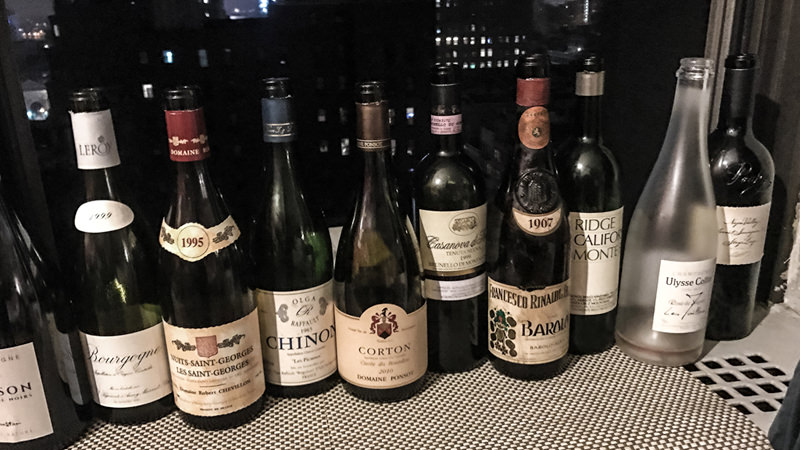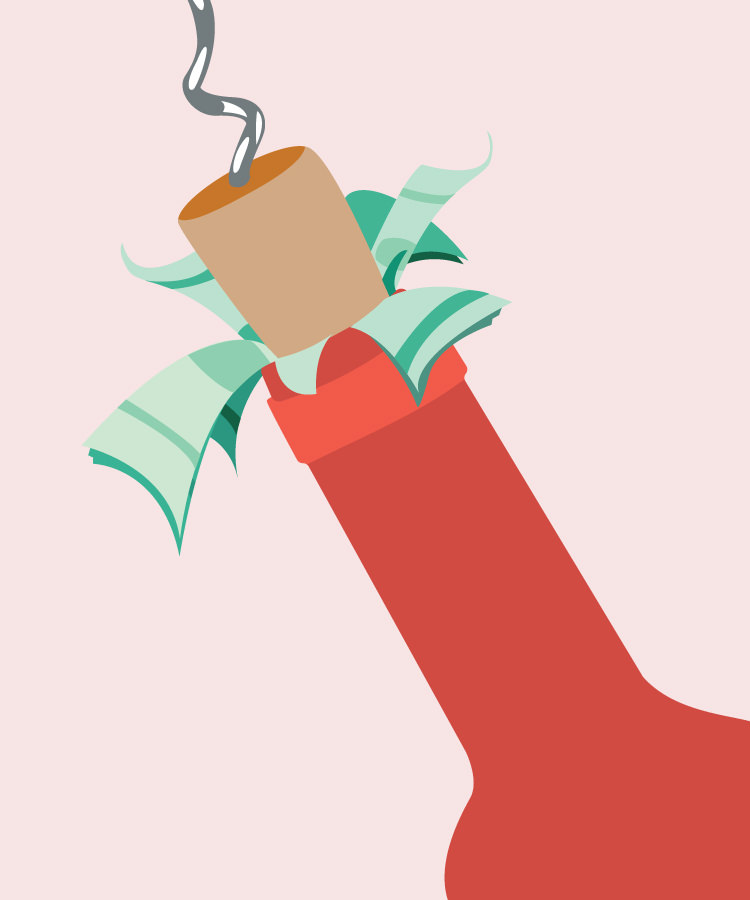When your friends are professional drinkers, Sunday Funday can be oddly stressful. A few months back, I was thrilled to be able to join a group of other sommeliers for a casual afternoon hang. I had a rare weekend day off from work and was looking forward to an afternoon of lounging in sweatpants and watching sports with friends. But I knew that, even though we’d be eating from paper plates balanced in our laps, our glasses would almost certainly be filled with delicious, nerdy, old, and expensive wine. And I had no idea what I could afford to bring.
By definition, wine professionals love and appreciate good wine. When socializing with other somms, what you pour matters. For a twentysomething living in an uncommonly expensive city like New York, this presents a challenge. Despite being among friends, I couldn’t shake the vague pressure to drink (very!) well among industry peers. Turns out, I’m not the only one.
Punching above your weight
“A lot has changed with regards to the image of a sommelier since I started in this business 15 years ago,” Eduardo Porto Carreiro, beverage manager for Atlanta’s Ford Fry restaurants, tells me. “But one thing that hasn’t changed is the adage of a typical somm’s behavior and habits: Live like a pauper, drink like a king.”
https://www.instagram.com/p/BX4mxluAw45/
Luckily, these days most somms are not paupers. According to the annual Guild of Sommeliers salary survey, the median income for U.S. sommeliers in 2016 was $60,000 ($70,000 in major markets like New York and San Francisco). That is well above the country’s overall median individual income and even surpasses other hospitality positions such as bartenders ($20,800 overall, $31,510 in New York) and waiters ($19,990 overall, $31,620 in New York).
While sommeliers do make above-average salaries, they generally don’t meet the required income to be considered upper class. However, that’s not what their wine purchasing habits would suggest.
The nine sommeliers I surveyed estimated their personal wine budgets run from $200 to $350 per month. (Several acknowledged that they occasionally exceed that figure.) When buying retail, they spend a median of $40 to $50 per bottle. By means of comparison, a 2015 Wine Market Council survey found that only 10 percent of all wine drinkers have spent more than $20 on a bottle of wine in the last month.
This divide is dramatic but logical. Sommeliers’ daily responsibilities include studying, opening, and tasting some of the world’s finest wines. Given the intimacy with which somms are expected to understand high-end bottles, they have to prioritize personal wine spending.
“I think wine people buy wine the way that fashion people buy clothes,” says Andrea Morris, beverage director at Nix in New York. “It’s one of my top passions, so I make other small sacrifices to make it happen.”
Go big or go home
https://www.instagram.com/p/BX4zaZlhOXb/
An interesting thing happens, though, when a group of sommeliers get together: Invariably, the budget for wine increases.
The sommeliers I spoke to had a median budget of $100 per bottle in a restaurant. This is likely higher than average for consumers within the same income bracket, but it didn’t strike me as excessive.
While most asserted that they do not feel pressure from industry peers, they also acknowledged that they tend to spend more or have a different budget expectation when dining with other sommeliers.
“When I dine out with other wine industry people, I can usually expect my check average to be a little bit higher, especially if the wine list is exciting,” says Nora Hoefer, sommelier at The Grill in New York. “I might bump my usual $100 [budget] to $200.”
Those paying attention might notice that this now-doubled budget comprises the entirety of these same somms’ monthly wine budget — on just one bottle.
Part of this pressure comes from sommelier culture. Whether or not somms are willing to state it outright, there is often the notion that industry members have lofty expectations.
“You don’t want to show up to a large dinner party with a bunch of people in the industry with a $45 bottle [if] the rest of the group has brought wines that are in the $150 to $300 [range],” says Celia Erickson, sommelier at New York’s Gramercy Tavern. If everyone shares bottles with one another, each sommelier wants to pull his or her weight.

It’s all about perception
Social media also affects how sommeliers perceive their spending habits versus those of their peers.
“Sometimes half of my Instagram feed is bottle shots of unicorn wine, and it can seem like everyone but me is drinking like that all of the time,” says Katie Venezia, sommelier at Marta in New York.
This can be exacerbated by the fact that, with the rise of “celebrity sommeliers,” many young somms use social media as a means of branding themselves.
“I keep in mind that a lot of my industry friends aren’t necessarily only posting what they’re drinking,” says Morris. Much of what sommeliers post are photos of bottles opened on the clock for guests, not ones purchased on their own dime. Sometimes, these “unicorn” bottles aren’t even on the somm’s own list.
“A lot of somms post wine that is brought in by guests for corkage but do not disclose that. They also may write tasting notes and act like they drank it,” says Knight. “Do not believe everything you see.”
That doesn’t mean that social media is all bad when it comes to wine-drinking culture, with some sommeliers asserting its value as an information-sharing tool.
“You can get such an understanding of the canon of wine from watching leading wine professionals drink,” says Morgan Harris, head sommelier at Aureole in New York City. “You stay appraised of what’s going on in the market, new releases, and newly imported wines.” Just keep in mind that those old and rare Insta shots need to be taken with a grain of salt.
“We’re not all crushing first growths and vintage Champagne every night of the week,” Morris adds.
Good value doesn’t always come cheap
https://www.instagram.com/p/BXtk5uzHV7j/
One common theme among all of the sommeliers interviewed was the notion of value. Most wine drinkers, regardless of their price point, seek value, and often they look to sommeliers to help them do so. The same is true for somms themselves, and they in fact have an advantage of recognizing value, as they spend much of their time dealing with wholesale wine pricing and markups. Interestingly enough, it’s this value proposition that can push a sommelier beyond his or her budget.
“Mostly where I get myself into trouble is when I see something on a list that may be expensive, but cheap for what it is,” says Harris. Though the bottle is actually over budget, somms recognize its value and feel as if they’re actually saving money. This can be tricky, particularly because many quality wine programs mark up higher-priced bottles less than they do lower-priced ones, percentage-wise.
“If I came across a great wine, I would weigh the value that it might offer and pull the trigger if I had the money to pay for it,” says Porto Carreiro.
“In that instance, you just pull out the plastic, sign up for a few more shifts, and hope it all works at the end of the month from a budgeting perspective,” Harris adds.
The secret to good deals
https://www.instagram.com/p/BWbmVc8nm55/?hl=en
“I once had a young, aspiring sommelier ask me where to find the secret, sommelier-only wine shop that sells crazy wine for next to nothing,” joked Venezia. “Sorry, kid, that doesn’t exist.”
The question is understandable; how exactly do sommeliers afford to drink great wine? While there isn’t a secret wine Disneyland, sommeliers do have some secrets to finding deals on wine, and it boils down to two things: research and connections. Unsurprisingly, in both of these aspects, sommeliers have a leg up.
“It takes a lot of time and research to find incredible bottles at great prices,” says Erickson. Being familiar with producers, vintages, and cuvées allows a sommelier to recognize that a wine may not be from a great year but is by a producer that consistently produces excellent wine. Or perhaps a wine is from a completely unknown producer, but the vineyard site is known for heralding excellent cuvées. Patience is key, and when that excellent deal comes along, it’s a good opportunity to purchase six bottles or a case to have at home for times when the budget isn’t as flexible.
Connections are the other key to finding great deals, whether they are with other sommeliers, wine shop clerks, or collectors. Building relationships with those in the industry is a gateway to the goodies that may not be available to the average consumer.
“You never know what bottles aren’t on a shelf, especially if it’s something older or highly allocated,” suggests Hoefer. Buyers for wine shops and restaurants will often hold on to special wines in the cellar or back room, either waiting to sell them in the future or saving them for particular customers. Sommeliers also build relationships with frequent guests who may be wine collectors.
“I have had the great fortune of meeting some wonderful, generous consumers in this business who have not only afforded me the opportunity to drink well on my days off, but learn from them in the process,” notes Chris Struck, sommelier at Union Square Cafe.
The other option is the old adage of “fake it ‘til you make it.” A good alternative to buying a high-end bottle is to seek out a value-driven bottle that’s both tasty and a little nerdy.
“You can’t go wrong with a reasonably priced bottle of sherry or grower Champagne,” says Struck. “Look for less well-known vintages, producers, grapes, and regions.”
Harris agrees: “If you can’t hang with other people’s spend, I don’t think anyone’s going to look down their nose at you for ordering yummy pét-nat or great Aligoté.”
For my aforementioned Sunday soirée dilemma, I ended up lucking out with a bottle of 1995 premier cru red Burgundy that had been previously gifted to me by a generous restaurant guest. I supplemented that with a bottle of grower Champagne purchased at wholesale cost that wasn’t necessarily high-end, but was super delicious and had a great story. The solution was a fortuitous combination of factors: connections, a geeky backup option, and the ability to purchase wine at a lower cost through my restaurant.
The way I see it, the so-called problem of wine spending is both cause and effect of passion. And true passion is priceless.
